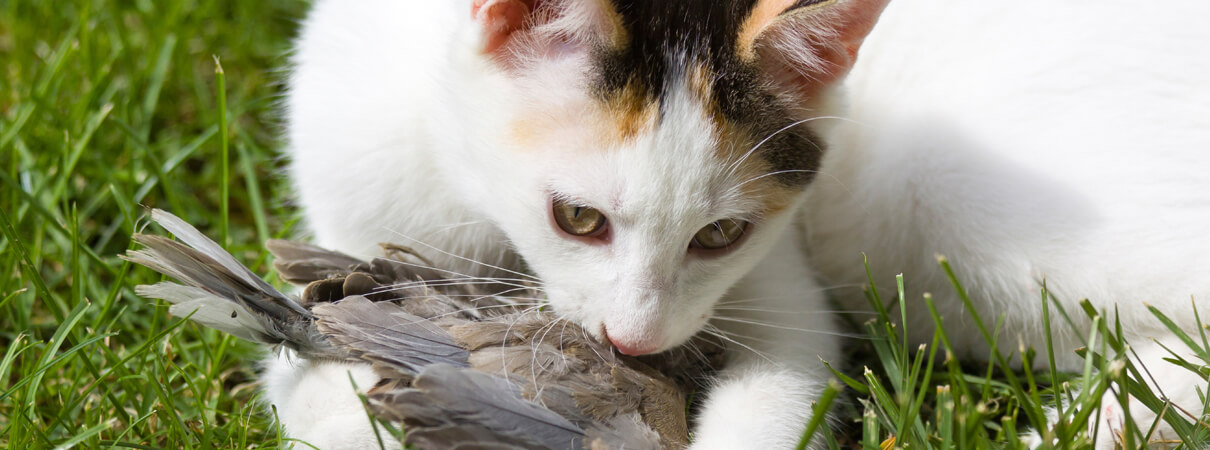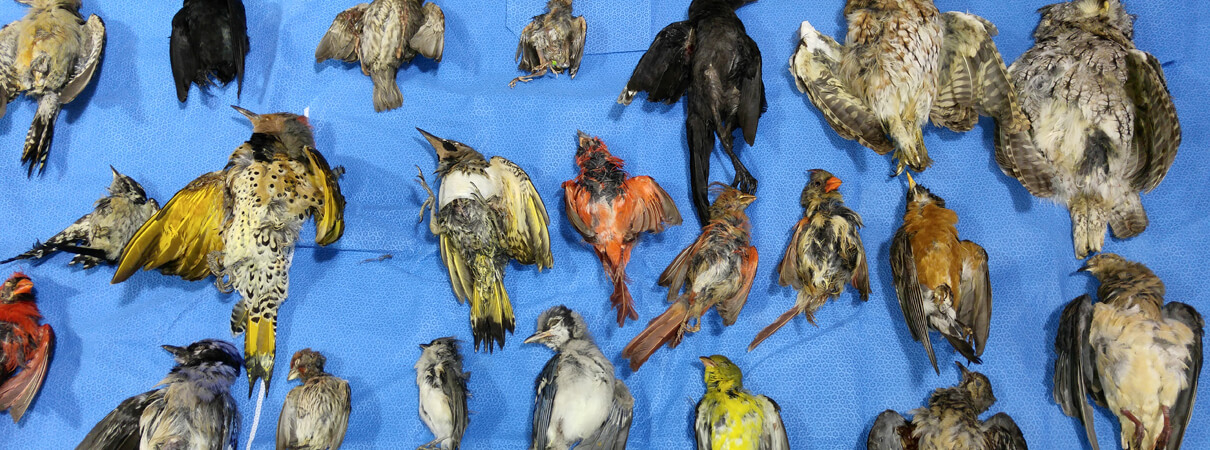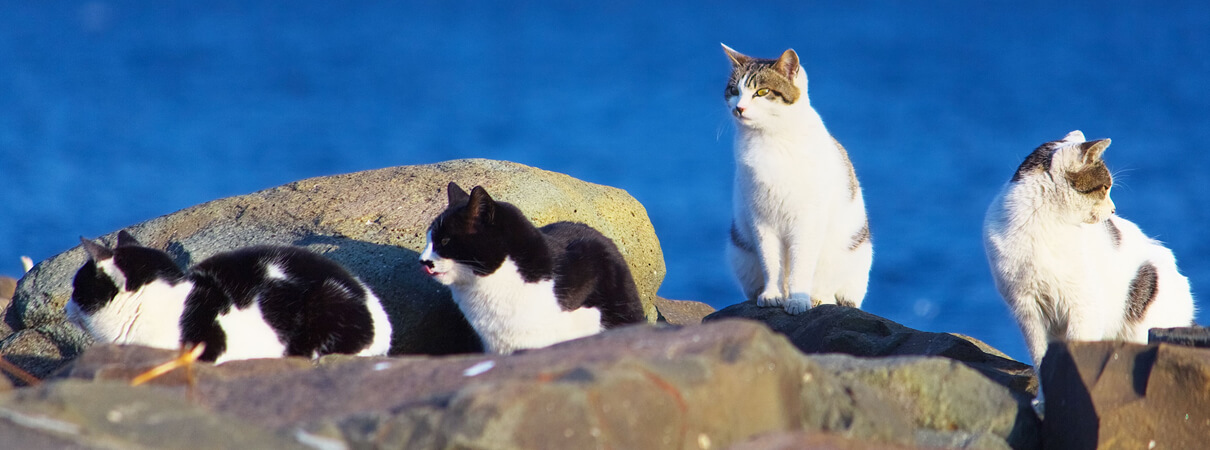'Cat Wars' Issues a Call to Action for the Birds of North America
Of all the human-caused direct mortality threats to birds, cats take the biggest toll, killing an estimated 2.4 billion birds a year. Dr. Peter P. Marra, a leading ornithologist and conservationist, is director of the Smithsonian Migratory Bird Center. He's also the co-author, with Chris Santella, of the new book Cat Wars: The Devastating Consequences of a Cuddly Killer (Princeton University Press, 2016). The book has been widely reviewed—and fiercely attacked by advocates for free-roaming cats. Grant Sizemore, director of ABC's Cats Indoors program, invited Marra to talk about the book and why addressing the cat problem is such an urgent concern for both bird conservation and public health.
Grant Sizemore: Why did you feel it was important to write this book?
Peter P. Marra: In spite of ABC's dedication, the crisis with outdoor cats wasn't getting enough recognition. The problem continues to get worse and worse, and many people aren't even aware that there's an issue—largely because of all the misinformation promoted by those who advocate for free-roaming cats. The book is an attempt to reach as many people as possible with the data and the science so we can reverse this problem.
GS: The media portrays this issue as “cats vs. birds.” Is that accurate?
PM: This is a people problem. Cats were domesticated and spread around the world by people. They become pets or pests depending upon people's actions. The title Cat Wars refers to the battle created by a small but extremely vocal minority of activists who voraciously attack any science that points to the impact cats are having on wildlife and on human health.
GS: Birds face many hazards, including habitat loss, collisions, and pesticides. How big a problem is cat predation relative to other causes of bird mortality?
PM: We analyzed the mortality rates associated with direct anthropogenic or human-created threats to birds—including building or window collisions, cars, wind turbines, and cats—on a yearly basis. Cats are by far the leading cause of mortality, with a median of 2.4 billion birds killed per year. Collisions with buildings or windows kill as many as 599 million birds, automobiles kill up to 200 million, and so on. Given the sheer numbers of both common and rare birds that are affected by cats, it's clear we need to direct a major effort at the outdoor cat problem.
GS: Cats are predators. It's natural for them to hunt birds. How do you respond to the argument that we shouldn't try to change the natural order?
PM: Domestic cats are as much a part of the natural order as a cow, pig, or golden retriever. They are not a natural part of any ecosystem on the planet—and people have caused them to spread from the place where they were initially domesticated (believed to be Cyprus) to every place in the world, except the poles. Domestic cats are pets and should be cared for as such—kept indoors or under our control at all times.
GS: Why should cats be treated any differently than other predators, such as owls and hawks?
PM: Owls, hawks, and other native predators occur at low enough densities that prey populations are not overwhelmed. The density of domestic cats typically increases beyond the carrying capacity of any environment, leading to unsustainable levels of predation.
GS: Should we distinguish between pet cats that go outdoors and feral cats?
PM: Neither should be allowed to roam free because of the harm they do to others (wildlife and people) and to themselves. Owned cats need to be treated like pet dogs. They should be kept indoors, on a leash or in a catio. Unowned cats, which have no owner to take responsibility, pose a risk to biodiversity and human health, and live dangerous, unhealthy lives. They need to be removed from the environment and put up for adoption, placed in a sanctuary, or euthanized.

"Owned cats need to be treated like pet dogs," says Peter P. Marra, coauthor of Cat Wars. "They should be kept indoors, on a leash or in a catio." Photo by istockphoto
GS: Do well-fed cats still kill birds?
PM: They still kill birds and other wildlife. There's plenty of data supporting this fact. Well-fed cats are known as subsidized predators and kill not for food but likely because it is instinctual.
GS: One of the solutions many cities and states are being encouraged to implement to deal with feral cats is Trap, Neuter, Release (TNR). Is TNR an adequate solution?
PM: The evidence does not support TNR as a viable solution to removing cats from the landscape. The hope was that TNR would provide a no-kill alternative to a euthanasia model for removing cats from the landscape. But TNR fails from a number of perspectives. Ironically, it causes cats to be re-abandoned in an environment where they are vulnerable to harm in the form of collisions with cars, predation by coyotes or raptors, and disease. The cats continue to impact biodiversity and spread disease, and the practice actually encourages more people to abandon their cats.

Cat-killed birds at the Wildlife Center of Virginia. Photo by Dr. Dave McRuer
GS: If not TNR, what are the solutions?
PM: There are no simple solutions. We have worked our way into a bind by allowing such irresponsible behavior with an invasive predator. Whatever the solution, it needs to be humane. We first need to put an end to the idea that it's okay for owned cats to be let outside. For unowned cats the situation becomes more complicated. First, we need to identify the areas where cats pose the greatest risk—to biodiversity and to human health—and are in the greatest danger themselves. Cats need to be removed from these areas immediately. Once they're removed, they can be adopted, put in a sanctuary or, as a last resort, euthanized.
GS: Cat Wars has been criticized for using the phrase “by any means necessary” with regard to feral cat management. Would you care to comment?
PM: That's a perfect demonstration of why the title is apropos. That phrase was taken completely out of context. Here's the complete version:
From a conservation ecology perspective, the most desirable solution seems clear—remove all free-ranging cats from the landscape by any means necessary. But such a solution is hardly practical given the legions of cats roaming the land—as many as 100 million unowned animals, plus the 50 million owned cats that roam—and the painful question of what to do with the cats even if they could be captured.
That last sentence makes it clear that the previous hypothetical is referring to capturing cats with non-lethal methods. One could say that the cat advocates are promoting their position using whatever means necessary, including unethical and deceitful approaches to what is a real problem.

A recent scientific paper reports that cats have contributed to 63 global species extinctions worldwide. Photo by Shutterstock
GS: How does the recent study by Doherty et al., which finds that cats have caused far more extinctions worldwide than we previously thought, support the argument of Cat Wars?
PM: It makes the message of Cat Wars even more urgent. A single species extinction is too many. The recent paper reports that cats have contributed to 63 global species extinctions worldwide. Cats are now implicated in 26 percent of all reptile, bird, and mammal extinctions in this, the sixth mass extinction—also known as the Age of the Anthropocene.
GS: A concept called “One Health” holds that human, wildlife, and domestic animal health are all related. How do cats affect the health of the species around them, including humans?
PM: Cats carry and transmit an enormous number of pathogens—from rabies to feline leukemia to Toxoplasma—all pathogens that can impact wildlife, cats, and/or people. Toxoplasma gondii, the protozoan pathogen that sexually reproduces only in cats, has permanently infected over 22 percent of people in the United States and over 30 percent of the global population. Toxoplasma oocysts permanently lodge in human brains and can result in a variety of changed behaviors, potentially even mental illnesses ranging from bipolar disorder to schizophrenia.
GS: Cat owners can help by keeping their cats indoors. What can non-cat-owners do?
PM: Citizens, whether they own cats or not, should demand that towns, counties, and states not allow the presence of cat colonies, and that they make TNR illegal—or at least require cat colonies to be securely enclosed. They could pressure lawmakers to enforce licensing and leash laws for cats. It's time we treat pet cats like pet dogs.

Peter P. Marra, Director of the Smithsonian Migratory Bird Center and coauthor of the new book Cat Wars. Photo by Tim Romano
GS: Cat Wars presents an inconvenient but urgent truth. Are there any similarities between the reaction to the science of cats and the science of climate change?
PM: The pushback and deliberate denial of science by cat advocates is completely analogous to what we experienced with climate change deniers. We have been hampered by so-called confirmation bias, where people believe what they wish to believe, rather than fact. That has left us in difficult environmental and public-health situation that will cost lives and billions of dollars.
GS: What gives you hope?
PM: Nature is resilient—as long as we take action. We hope Cat Wars is that call for action. Given the declines we're seeing with the birds of North America, removing a threat as significant as cats will give many of these remarkable species a chance to recover.
That's the encouraging part of the cat issue. We can solve the problem.
 Grant Sizemore is American Bird Conservancy's Director of Invasive Species Programs. He has degrees in Zoology and Environmental Science from Miami University and an M.S. in Wildlife Ecology and Conservation from the University of Florida. Grant has worked toward wildlife conservation through policy, outreach, education, and years of research. He enjoys hiking, birding, and taking care of his (indoor) cat.
Grant Sizemore is American Bird Conservancy's Director of Invasive Species Programs. He has degrees in Zoology and Environmental Science from Miami University and an M.S. in Wildlife Ecology and Conservation from the University of Florida. Grant has worked toward wildlife conservation through policy, outreach, education, and years of research. He enjoys hiking, birding, and taking care of his (indoor) cat.


















































